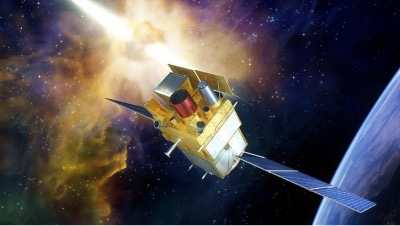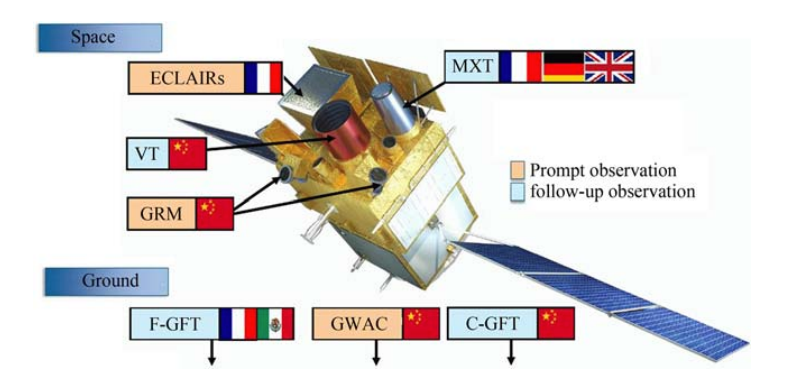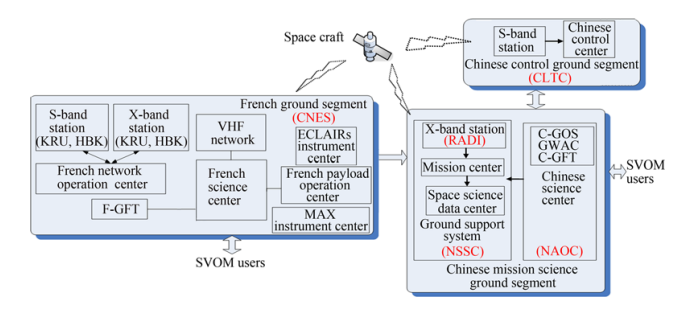Space Variable Objects Monitor
(SVOM)
The Space Variable Objects Monitor (SVOM) is an astronomical satellite jointly developed by the China National Space Administration (CNSA) and the French National Centre for Space Studies (CNES). It was launched on June 22, 2024, from the Xichang Satellite Launch Center aboard a Long March 2C carrier rocket. The satellite's core scientific objective is to detect gamma-ray bursts (GRBs). It is equipped with four scientific payloads: the Gamma-Ray Burst Monitor (GRM), the Visible Telescope (VT), the ECLAIRs hard X-ray camera, and the Microchannel X-ray Telescope (MXT). China was responsible for developing the GRM and VT, while France developed the ECLAIRs and MXT.
The satellite was developed under a joint Sino-French model, with the Chinese side responsible for constructing the satellite platform and the French side participating in payload development and the ground system. Its X-ray focusing optics, which use a lobster-eye design, were developed by the University of Leicester in the UK. SVOM has wide-field detection and rapid-response capabilities, enabling it to trigger an alert network and form a coordinated space-ground observation system with ground-based telescopes.

The main scientific objectives of the SVOM satellite include:
Discovering and rapidly locating various types of gamma-ray bursts
Comprehensively measuring and studying the electromagnetic radiation properties of GRBs
Using GRBs to study dark energy and the evolution of the universe
The SVOM satellite carries an equal number of Chinese and French astronomical instruments, comprising four payloads: the Gamma-Ray Burst Monitor (GRM), the ECLAIRs hard X-ray camera, the Microchannel X-ray Telescope (MXT), and the Visible Telescope (VT).

ECLAIRs (Hard X-ray Camera):
With an observation band of 4-250 keV and a field of view of about 8,000 square degrees, its purpose is to determine the position, intensity, and duration of GRBs. Its coded mask allows it to provide a preliminary GRB position with a localization accuracy of about 10 arcminutes.
GRM (Gamma-Ray Burst Monitor):
It has an observation band of 50 keV - 5 MeV and a field of view of about 8,000 square degrees. Its main function is to measure the high-energy spectral features of GRBs.
MXT (Microchannel X-ray Telescope):
It operates in the 0.3-6 keV spectral band with a field of view of about 65x65 square arcminutes. Its function is to measure the X-ray afterglow of GRBs (the subsequent radiation from a GRB) and provide a position with an accuracy of ~20 arcseconds. This level of accuracy allows most ground-based telescopes to perform follow-up photometric observations.
VT (Visible Telescope):
Operating in the 400-950 nm spectral band with a field of view of about 26x26 square arcminutes, its function is to measure the optical afterglow of GRBs and provide a position with an accuracy of ~1 arcsecond. This enables large-aperture ground-based telescopes to conduct follow-up spectroscopic observations.
SVOM employs a strategy of coordinated space-ground observations of GRBs. The satellite discovers and locates the bursts, and both its onboard payloads and ground-based telescopes conduct follow-up observations and positioning.
The overall SVOM mission is divided into three parts with different scientific objectives:
1.Core Program (CP): This consists of an automatic observation system triggered by unpredictable GRBs. These observations take precedence over all other types. The goal is to detect all known types of GRBs, obtain fast and reliable positions, and measure the spectral shape and time-variability of the prompt emission from visible light to X-rays.
2.Target of Opportunity (ToO): This corresponds to specific, urgent observation requests. For example, SVOM can provide useful data to aid gravitational wave detectors (like the upgraded VIRGO and LIGO) by searching for gravitational wave signals that coincide in spacetime with short GRBs, thereby improving the detectors' ability to reject noise.
3.General Program (GP): This utilizes the narrow-field instruments (MXT and VT) for planned observations of known targets. Priority targets include Active Galactic Nuclei (AGN), Blazars, Ultraluminous X-ray sources (ULXs), and Cataclysmic Variables (CVs). These broadband observations will provide unique information for studying the physics of radiation processes in extreme celestial objects. The observation schedule is based on an annual solicitation of proposals for the upcoming year.
Additionally, SVOM will perform regular in-flight instrument calibrations. The satellite's target retasking strategy is designed to accommodate any serendipitous events or urgent observation requests by interrupting ongoing tasks, ensuring that the objectives of the Core Program, Targets of Opportunity, and General Program are met to the greatest extent possible.
According to the cooperation agreement signed by China and France, the CNSA and CNES collaborate on engineering development and in-orbit operations. The division of labor is as follows:
1.The Chinese side is responsible for the project, with the French side handling parts of the research and development.
2.Both parties cooperate as equals at the system level (e.g., system definition, implementation, and testing).
3.The Chinese side is responsible for the overall satellite and the platform, while both China and France provide payloads.
4.The Chinese side is responsible for the launch vehicle and launch site, using a Long March 2C rocket to launch SVOM from the Xichang Satellite Launch Center.
5.The Chinese side manages in-orbit operations and control. The ground segment was jointly designed and is built separately by each party. The Chinese ground segment includes the mission center, control center, and science network center. The French ground segment includes the payload operations center and the VHF science center.

Data Access:https://svom.ac.cn//